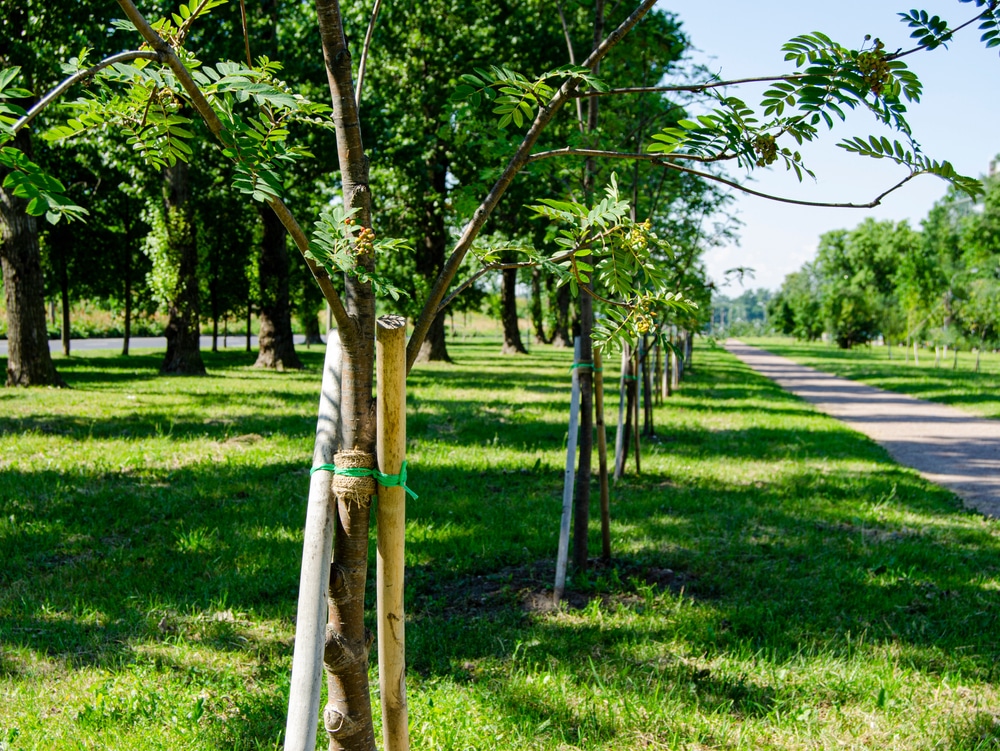Transplanting trees is not only a practical necessity in landscaping and urban development, but also an art and a science. At Environmental Design Inc., we understand the importance of preserving and relocating trees with the utmost care and precision for successful re-establishment. Our expertise in tree relocation and use of state-of-the-art equipment like Arborlift allow us to handle even the most challenging projects, ensuring your trees continue to flourish in their new homes. Join us as we discuss the intricacies and considerations of transplanting these ten popular tree species in the USA.
1. Oak Trees (Quercus)
Oak trees are among the most iconic and widespread trees in the United States, known for their strength, longevity, and distinctive lobed leaves. However, transplanting oak trees, especially mature ones, can be quite challenging. The deep taproots and extensive lateral root systems of oaks make them difficult to dig up without causing significant damage. Younger oak trees are easier to transplant because their root systems are not as developed, but they still require careful handling to ensure successful relocation.
One of the main complications in moving oak trees is their size and weight. Mature oaks are heavy and require specialized equipment and experienced personnel to handle the move. Additionally, the deep root systems of older oaks necessitate root pruning several months before the move to encourage the growth of new feeder roots, which can help reduce transplant shock and increase the likelihood of successful establishment in the new location.
While most oak species are not endangered, specific subspecies like the Blue Oak (Quercus douglasii) and the Engelmann Oak (Quercus engelmannii) are considered rare and may require special permits for relocation. These species have more restricted ranges and specific habitat requirements, making their conservation critical. Oaks are widespread across the USA, with significant populations in the Eastern and Central states. They are commonly found in forests, parks, and residential areas, providing shade, habitat for wildlife, and aesthetic value.
2. Maple Trees (Acer)
Maple trees are another popular choice for transplantation due to their vibrant fall colors and adaptability. They have fibrous root systems that are relatively shallow but spread wide, making them easier to transplant than deeper-rooted trees. However, the wide-spreading roots of maples are aggressive and can compete with nearby plants for water and nutrients, which needs to be considered during relocation.
Transplanting maple trees requires careful attention to include as much of the root system as possible to ensure successful establishment in the new location. Maples can suffer from transplant shock if too much of the root system is damaged or left behind. It’s also important to transplant them during their dormant season to minimize stress. Post-transplant care, including regular watering and mulching, is essential to help the tree establish in its new location and thrive.
While common maples like the Sugar Maple (Acer saccharum) and Red Maple (Acer rubrum) are not endangered, certain species such as the Bigleaf Maple (Acer macrophyllum) have smaller, more localized populations and may require additional consideration during relocation. Maples are found throughout the USA, particularly in the Northeast and Midwest. They are popular in urban and suburban landscapes for their vibrant fall colors and attractive form.
3. Pine Trees (Pinus)
Pine trees are commonly transplanted due to their rapid growth and role in providing windbreaks and privacy screens. Young pines are relatively easy to transplant because their root systems are not yet fully developed, consisting of a central taproot with a network of smaller lateral roots. However, as pines mature, their taproots can grow deep, making older pines more challenging to move.
The taproot of mature pines can be challenging to extract without causing damage. However, their overall root structure makes them one of the easier trees to transplant successfully when young. Pines require well-drained soil and can suffer from root rot if their roots are exposed to excessive moisture during or after the transplant process. Therefore, it’s crucial to ensure proper soil conditions and post-transplant care.
Pines are generally abundant, but certain species like the Ponderosa Pine (Pinus ponderosa) are more localized. Some pine species are also subject to threats such as the mountain pine beetle, which can complicate their transplantation and management. Pines are prevalent across the USA, with significant populations in the Southeast, West, and Rocky Mountain regions. They are commonly used in reforestation projects, windbreaks, and ornamental plantings.
4. Magnolia Trees (Magnolia)
Magnolia trees are prized for their large, fragrant flowers and glossy leaves, making them a popular choice in southern landscapes. However, transplanting magnolia trees, especially mature ones, can be challenging due to their root systems. Magnolias have a combination of deep and lateral roots, which are sensitive to disturbance and can suffer from transplant shock if not handled properly.
To successfully transplant magnolias, it’s important to dig a wide and deep root ball to include as many roots as possible. Magnolias prefer slightly acidic, well-drained soil, which should be matched at the new location to ensure successful establishment. Additionally, magnolias require regular watering and proper care post-move to prevent stress and promote healthy growth.
While common magnolias like the Southern Magnolia (Magnolia grandiflora) are not endangered, some species, such as the Ashe Magnolia (Magnolia ashei), are rare and may be protected under local laws. Magnolias are primarily found in the southeastern USA, with some species also growing in the West. They are popular in residential and commercial landscapes for their large, fragrant flowers and attractive foliage.
5. Dogwood Trees (Cornus)
Dogwood trees are cherished for their spring blooms and attractive form, making them a popular choice for transplantation. They have shallow, fibrous root systems that spread widely but remain close to the surface, which makes them relatively easy to transplant. However, the shallow roots also make them vulnerable to drought if not properly watered after relocation.
To successfully transplant dogwoods, it’s important to ensure they are moved during their dormant season and to provide regular watering, especially during the first few years after transplanting. Dogwoods also prefer well-drained, slightly acidic soil and thrive in partially shaded locations. These conditions need to be replicated at the new site to ensure the tree’s successful establishment and growth.
The flowering dogwood (Cornus florida) is common, but certain varieties like the Pacific Dogwood (Cornus nuttallii) are less widespread and may need special consideration. Dogwoods are common in the Eastern USA and the Pacific Northwest. They are popular for their spring blooms and attractive fall foliage, making them a favorite in ornamental landscapes.
6. Cedar Trees (Cedrus)
Cedar trees are commonly moved for their durability and use in privacy hedges. They have a shallow, fibrous root system that spreads wide, making them suitable for transplantation. Their roots are generally adaptable but require careful handling to avoid damage during the move.
Cedars are relatively straightforward to transplant but require proper watering and care post-move. They are susceptible to transplant shock if their roots dry out or if they are exposed to extreme temperatures during the move. Ensuring the tree is moved during its dormant season and providing consistent watering can help mitigate these risks and promote successful establishment.
Cedars are generally abundant, though some species, like the Atlantic White Cedar (Chamaecyparis thyoides), are less common and can be subject to conservation efforts due to their specific habitat requirements. Cedars are found in the Eastern USA, the Pacific Northwest, and parts of the Southwest. They are often used for privacy screens, windbreaks, and ornamental plantings due to their evergreen foliage and aromatic wood.
7. Cherry Trees (Prunus)
Cherry trees are known for their beautiful spring blossoms and are frequently relocated in urban and suburban settings. They have a shallow and wide-spreading root system, which makes them relatively easy to transplant when young. However, their roots are sensitive to disturbance, and care must be taken to include as much of the root system as possible.
Cherry trees are susceptible to root damage and require careful handling during transplantation. They are also prone to diseases such as cherry leaf spot and black knot, which can be exacerbated by the stress of moving. To ensure successful transplantation, it’s important to dig a wide root ball and provide regular watering and care post-move.
While many cherry species are common, some ornamental varieties, such as the Yoshino cherry (Prunus x yedoensis), may be rare or have specific growing requirements that need to be considered during relocation. Cherry trees are commonly found in the Northeast, Midwest, and Pacific Northwest. They are celebrated for their beautiful spring blossoms and are often featured in parks, gardens, and along streets.
8. Birch Trees (Betula)
Birch trees are valued for their distinctive bark and delicate foliage, making them a popular choice for transplantation. They have shallow, fibrous roots that spread widely, making them easier to transplant compared to deeper-rooted trees. However, their roots are sensitive to changes in soil moisture and require consistent watering post-transplant.
Birches require moist soil conditions post-transplant to prevent stress and promote successful establishment. They can suffer from transplant shock if their roots dry out or if they are exposed to extreme heat or cold during the move. To ensure successful transplantation, it’s important to move them during their dormant season and provide consistent watering and care.
The Paper Birch (Betula papyrifera) and River Birch (Betula nigra) are common, but some species like the Yellow Birch (Betula alleghaniensis) are more localized and less common, requiring careful consideration during relocation. Birches are found throughout the Northern USA, particularly in the Northeast and along the Great Lakes. They are popular in ornamental landscapes for their distinctive bark and delicate foliage.
9. Elm Trees (Ulmus)
Elm trees are commonly moved to preserve their historical and aesthetic significance, especially in areas affected by Dutch Elm Disease. They have extensive, shallow root systems that can spread widely, making them relatively easy to transplant. However, their roots are generally adaptable but require careful handling to avoid damage during the move.
Elm trees can suffer from transplant shock, so careful handling and post-transplant care are essential. They are also susceptible to Dutch Elm Disease, which can complicate their transplantation and management. To ensure successful transplantation, it’s important to move them during their dormant season and provide consistent watering and care post-move.
While American Elms (Ulmus americana) were once widespread, Dutch Elm Disease has significantly reduced their populations, making healthy specimens more valuable and often requiring disease-resistant varieties for new plantings. Elms are found across the USA, particularly in the Northeast, Midwest, and Great Plains. They are commonly used as street trees and in parks due to their broad, arching canopies and adaptability to urban environments.
10. Cypress Trees (Cupressus)
Cypress trees are frequently relocated for their adaptability to wet conditions and use in creating natural screens and windbreaks. They have shallow, fibrous roots that are well-suited for transplantation. Their roots are generally adaptable but require careful handling to avoid damage during the move.
Cypress trees are relatively easy to transplant, but they need consistent watering during establishment to prevent stress and promote healthy growth. They are susceptible to transplant shock if their roots dry out or if they are exposed to extreme temperatures during the move. Ensuring the tree is moved during its dormant season and providing consistent watering can help mitigate these risks.
The Bald Cypress (Taxodium distichum) and Leyland Cypress (Cupressus × leylandii) are common, but some species like the Arizona Cypress (Cupressus arizonica) are more localized. Cypress trees are found in the Southeast, particularly in wetland areas, and also in the Southwest and California. They are valued for their adaptability to various soil conditions and their use in creating natural screens and windbreaks.
Conclusion
Transplanting trees is an essential practice in preserving the ecological and aesthetic value of landscapes across the USA. Each tree species presents unique challenges and considerations, from their root systems to potential complications during the move. Understanding these factors can help ensure successful transplantation and the continued health and growth of these vital natural resources. Whether for preserving mature trees during construction or enhancing the beauty of a landscape, careful planning and execution are key to successful tree relocation. By following best practices and providing proper care, these commonly transplanted trees can thrive in their new environments, contributing to the sustainability and beauty of our landscapes.
Environmental Design Inc.
For expert tree relocation services that comply with environmental regulations and ensure the health and success of your trees, trust Environmental Design Inc. Our team of experienced professionals uses state-of-the-art equipment and techniques to handle all your tree moving needs. Visit our website to learn more about our services and how we can assist with your tree relocation projects. Contact us today to ensure your trees are moved safely and effectively, preserving their beauty and health for years to come.




Recent Comments